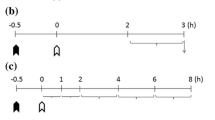Summary
The antiprotozoal drug metronidazole, when administered orally at a dose level of 100 mg/kg body wt. daily for 7 days to rats, brought about significant elevation of renal brush-border-membrane-bound hydrolytic enzymes, such as alkaline phosphatase, maltase, sucrase, and leucine aminopeptidase (LAP). Kinetic analysis of the enzymes (substrate saturation) indicated that the drug produced an increase in the maximum of apparent initial enzyme velocity (V max), while the substrate affinity constant (K m) remained unaltered. These changes were not recovered to the normal level event after the drug regimen was stopped and the animals were allowed to recover for a period of 7 days. Lipid analysis of brush border membrane (BBM) revealed a significant elevation in the cholesterol, phospholipid, and ganglioside levels, while no marked change was recorded in triglyceride, free fatty acid and plasmalogen. Study of the temperature-dependent parameters of the enzymes showed that metronidazole induced a shift in the transition temperature (T o) in LAP with nearly total reversibility in the recovery group. No such change was seen in the other enzymes. However, there also was a lowering in the energy of activation (E a) belowT o, which returned to normal after the treatment was withdrawn.
Similar content being viewed by others
References
Ames BN (1966) Assay of inorganic phosphate, total phosphate and phosphatase. Methods Enzymol 8:1150–1155
Barenholtz Y, Thompson TE (1980) Sphingomyelin in bilayers and biological membranes. Biochim Biophys Acta 604:129–158
Belivean R, Strevey J (1988) Kinetic model for phosphate transport in renal brush border membranes. Am J Physiol 254:F329-F336
Bergmeyer HU (1963) Phosphatases (phosphomonoesterases): determination in serum withp-nitrophenylphosphate. In: Bergmeyer HU (ed) Methods of enzymatic analysis. Academic Press, New York, pp 783–785
Bertoli E, Messerini M, Sonnison S, Ghidoni R, Cestro B, Tettamanty G (1981) Electron paramagnetic resonance studies on the fluidity and surface dynamics containing gangliosides. Biochim Biophys Acta 467:197–202
Bost RG (1977) Toxicology and teratology. In: Finegold J, McFadzen JA, Rose FJC (eds) Metronidazole. Proceedings of the International Metronidazole Conference, Montreal
Boyadzhieva M (1988) Metronidazole potentiated embryotoxic and teratogenic action of alcohol. Eksp Med Morfol 27:2–9
Brasitus TA, Schachter D (1980) Lipid dynamics and lipid-protein interactions in rat enterocyte basolateral and microvillus membranes. Biochemistry 19:2763–2770
Carruthers A, Melchoir DL (1984) Human erythrocyte hexose transporter activity is governed by bilayer lipid composition in reconstituted vesicles. Biochemistry 23:6901–6911
Chrystal EJT, Kock RL, McLafferty MA, Goldman P (1980) Relationship between metronidazole metabolism and bactericidal activity. Antimicrob Agents Chemother 18:566–573
Dahlqvist A (1964) Method for the assay of intestinal disaccharidases. Anal Biochem 7: 18–25
Deutsh G, Forster JL, McFadzen JA, Parnell M (1975) Human studies with high dose of metronidazole. A nontoxic radiosensitizer of hypoxic cells. Br J Cancer 31:75–80
Edson RS (1981) Metronidazole: unanswered questions. Lancet I:818–819
Folch J, Lees M, Solane-Stanley GH (1957) A simple method for the isolation and purification of total lipids from nervous tissue. J Biol Chem 226:497–509
George SG, Kenny AG (1973) Studies on the enzymology of purified preparations of brush border membrane from rabbit kidney. Biochem J 134:43–57
Goldberg JA, Ruttenberg AM (1958) The colorimetric determination of leucine aminopeptidase in urine and serum of normal subjects and patients with cancer and other diseases. Cancer 11:283–291
Goodman LA, Gilman A (1965) The pharmacological basis of therapeutics. Macmillan, New York, pp 1141–1143
Hildon SA, Sactor B (1979) D-glucose dependent sodium transport in renal brush border membrane vesicles. J Biol Chem 254:7090–7097
Ings RMJ, Lav GM, Parnell EW (1966) Metabolism of metronidazole. Biochem Pharamcol 15:515–519
Lees M, Paxman S (1972) Modification of Lowry's procedure for analysis of proteolipid protein. Anal Biochem 47:184–192
Lineweaver H, Burk D (1934) The determination of enzyme dissociation constants. J Am Chem Soc 56:658–666
Lowry RR, Tinsley JJ (1976) The colorimetric determination of free fatty acids. J Am Oil Chem Soc 53:470–475
Malathi P, Preiser T, Fairclough P, Mallet P, Crane RK (1979) A rapid method for isolation of kidney brush border membrane. Biochim Biophys Acta 554:259–269
Miklos M (1983) Mode of action of metronidazole on anaerobic bacteria and protozoa. Surgery 93:165–177
Mitnick MA, Demarco B, Gibbon GH (1980) Amniotic fluid phosphatidyl glycerol and phosphatidyl inositol separated by stepwise development of thin layer chromatography. Clin Chem 26:277–281
Roe FJC (1979) A critical appraisal of the toxicology of metronidazole. In: Philips I, Collier M (eds) Metronidazole. Proceedings of Second International Symposium on Anaerobic Infections, Geneva, pp 214–222
Roe FJC (1983) Toxicologic evaluation of metronidazole with particular reference to carcinogenic, mutagenic and teratogenic potential. Surgery 93:158–167
Rouser G, Nelson GJ, Fleischer S, Simon G (1968) Lipid component of animal cell membranes, organelles and ogans. In: Champman D (ed) Biological membranes. Academic Press, New York, pp 4–69
Rusita M, Shilbik P (1972) Induction of lung tumors and malignant lymphomas in mice by metronidazole. J Natl Cancer Inst 48:721–727
Sanyal SN (1987) Stimulation of uridinediphosphate galactose: ceramide galactosyl transferase by certain soluble protein factor in rat brain cytosol. Ind J Exp Biol 25:606–612
Schacter E, Letellier L, Gullick-Kryzwick T (1974) Relation between structure and function in cytoplasmic microvilli isolated fromE. coli fatty acid auxotroph. Eur J Biochem 49: 61–67
Segel IH (1976) Biochemical calculations. Wiley, New York, pp 277–281
Semer JM, Friedland P, Varisberg H, Greenberg AL (1966) The use of metronidazole in the treatment of alcoholism. Am J Psychiatry 123:722–734
VanHandel E, Zilversmit DB (1957) Micromethod for direct determination of serum triglycerides. J Lab Clin Med 50:152–157
Warren L (1959) The thiobarbituric acid assay of sialic acids. J Biol Chem 234:1971–1976
Williams JN Jr, Anderson CE, Jasik AD (1962) Sensitive and specific method for plasmalogens and other enol-ethers. J Lipid Res 3:378–381
Zlatkis A, Zak B, Boyle AJ (1953) A new method of direct determination of serum cholesterol. J Lab Clin Med 41:486–492
Author information
Authors and Affiliations
Rights and permissions
About this article
Cite this article
Jamba, L., Sanyal, S.N. Changes in membrane-bound hydrolases by metronidazole in rat renal brush border. Res. Exp. Med. 192, 287–294 (1992). https://doi.org/10.1007/BF02576285
Received:
Accepted:
Issue Date:
DOI: https://doi.org/10.1007/BF02576285



